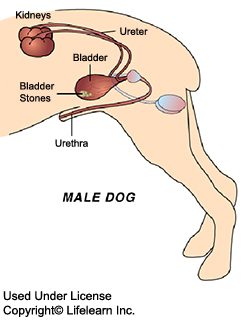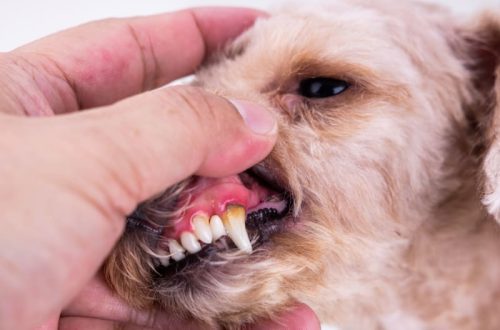
Уролитијаза кај кучиња: симптоми и третман
Bladder stones form when minerals in the urine coalesce into a mineralized mass that veterinarians call urolith. The two most common types of bladder stones in dogs are struvite and oxalate stones. About the diagnosis and treatment of urolithiasis in dogs – later in the article.
содржина
Bladder stones in a dog: symptoms
Urolithiasis in pets can occur both with symptoms characteristic of diseases of the lower urinary tract, and asymptomatically. The signs of the disease in a dog are as follows:
- болно мокрење;
- blood in the urine or a change in the color of the urine;
- acrid urine;
- честа желба за мокрење;
- urination in the wrong place;
- licking the genital area more often than usual;
- lethargy or decreased appetite;
- повраќање.
Bladder stones in a dog: diagnosis
Typically, veterinarians can diagnose bladder stones in dogs with an x-ray or abdominal ultrasound. Probably, the specialist will also prescribe a urinalysis for the dog and a culture test – seeding for bacteria. Because tumors and infections can present with the same clinical signs as bladder stones, it is important to follow all of your veterinarian’s recommendations.
What are struvite stones in dogs
Struvite stones are one of the most common types of bladder stones in dogs. Struvite is a hard mineral deposit that is formed in the urine from magnesium and phosphate ions. By themselves, struvite crystals in the urine are relatively common and not a problem.
In animals, struvite stones usually form in urine contaminated with ammonium-producing bacteria. This raises the pH of the urine, causing the struvite crystals to stick together, forming a stone.
Struvite Stones: Risk Factors
According to the Veterinary Information Network, 85% of dogs with struvite stones are female. The average age of such pets is 2,9 years.
Shih Tzus, Schnauzers, Yorkshire Terriers, Labrador Retrievers, and Dachshunds are at increased risk for struvite stones. The formation of such stones is most often associated with a lower urinary tract infection.
Treatment of struvite stones
According to the American College of Veterinary Internal Medicine (ACVIM), a veterinarian is likely to suggest dietary dissolution of struvite stones. In other words, he will recommend a diet for canine kidney stones.
Check with your veterinarian if a medicated diet, such as Hill’s Prescription Diet, is right for your pet. If the stone formation is due to a urinary tract infection, the specialist may also prescribe antibiotics.
Also among the recommendations is lithotripsy, a procedure for crushing stones in the dog’s bladder.
The last possible treatment option is surgical removal of the stones. Since this option is much more invasive, it is resorted to only as a last resort. It is necessary when there is a high risk of urinary tract obstruction, which may jeopardize the health of the pet in the near future.
What are oxalate stones in dogs
Whereas higher urinary pH contributes to struvite stone formation in dogs, urinary pH is less likely to influence oxalate stone formation. Such stones are formed in the urine with an excess of calcium and oxalate in it.
Oxalate Stones: Risk Factors
Oxalate stones, unlike struvite stones, are more common in males than females, according to a study published in the Canadian Veterinary Journal. In addition, older dogs are more prone to their formation.
According to the above study, the average age of a dog with oxalate stones is 9,3 years. While any dog can develop these stones, Keeshonds, Norwich Terriers, Norfolk Terriers, and Pomeranians are at higher risk.
Recently, researchers at the University of Minnesota discovered a genetic defect responsible for the development of urolithiasis in dogs and the formation of oxalate stones, and a genetic test is currently available for English Bulldogs. They also identified a similar mutation in American Staffordshire Terriers, Border Collies, Boston Terriers, Bullmastiffs, Havaneses, Rottweilers, and Staffordshire Bull Terriers.
Oxalate stones can form in sterile urine and are not usually associated with a lower urinary tract infection.
Treatment of oxalate stones
Unlike struvite stones, oxalate stones cannot be dissolved with nutrition. They can be removed surgically or with non-surgical procedures such as lithotripsy or retrograde urohydropropulsion.
It is imperative to pass stones for analysis, since some dogs can form several types of stones in the bladder at once.
Prevention of urolithiasis in dogs: the role of nutrition
Diet and water intake play an important role in preventing disease and recurrence.
Since crystals and stones are less likely to form in dilute urine, it is essential to increase your dog’s fluid intake and provide him with food that helps reduce the amount of minerals in the urine. To increase your pet’s water intake, you can moisten his food, give preference to canned food, season the water with low-salt chicken or beef broth. An alternative option is to put a drinking fountain on your pet.
In addition, you can feed your dog a food specially formulated to reduce the risk of stone formation. For example, Hill’s Prescription Diet is a high quality, complete and balanced therapeutic diet that provides your dog with all the nutrients it needs and reduces the risk of oxalate and struvite crystals by reducing the amount of minerals in the dog’s urine. Foods that help reduce the risk of bladder stones are available both in canned and dry form.
Even if a dog has developed bladder stones, steps can be taken to reduce the risk of recurrence or increase the time interval between them.
Your veterinarian may recommend x-rays, ultrasounds, or urinalysis once or twice a year to monitor your dog so that if new stones form, they can be removed by non-surgical methods. Together with a specialist, it will be possible to provide the necessary ways to care for and monitor the pet.
If the owner has any questions or concerns about their dog’s bladder stones, they should contact their veterinarian right away. It is he who will give the best recommendations for maintaining the health of the pet.





